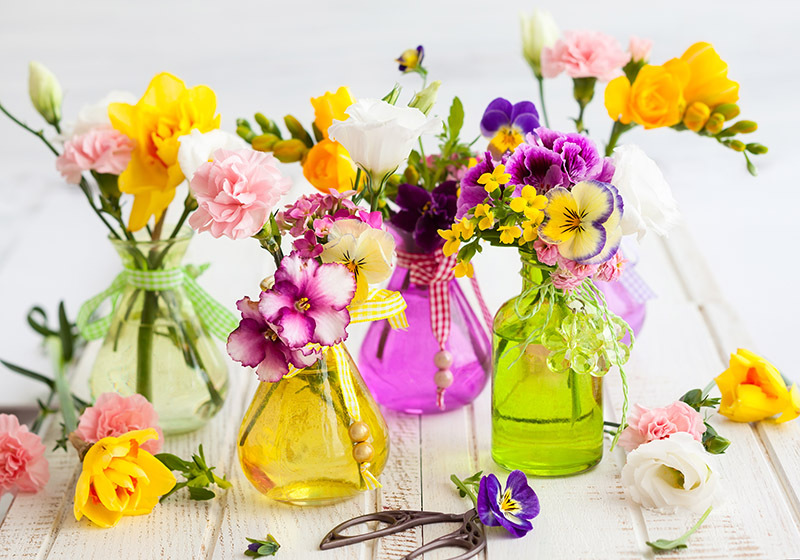Orchid Care Demystified: A Simple and Effective Approach
Posted on 18/08/2025
Orchid Care Demystified: A Simple and Effective Approach
Unlock the secrets of vibrant, long-lasting orchids with this simple and effective guide. Whether you're a first-time grower or an experienced plant enthusiast, mastering orchid care doesn't have to be mystifying.

Understanding Orchids: Beauty Meets Complexity
Orchids are among the most captivating houseplants. Their delicate blooms and exotic allure make them favorites worldwide. However, the stigma of complexity surrounds orchid care, causing apprehension among new growers. The reality? With a simple, clear approach, anyone can help their orchid flourish.
Why Orchids Seem Intimidating
- Diverse Species: With over 25,000 varieties, care specifics can seem daunting.
- Unique Needs: Orchids differ from common houseplants, requiring a tailored touch.
- Misconceptions: Myths about orchids being "difficult" often discourage potential growers.
Let's demystify orchid care with actionable insights and a simple framework to help you succeed.
Orchid Care Basics: The Foundation for Success
At its heart, successful orchid care is about understanding a few key principles:
- Right environment: Mimicking natural habitat.
- Proper watering: Neither too much nor too little.
- Correct light: Bright, indirect is usually best.
- Adequate feeding: Fertilizing at the right intervals.
Choosing Your Orchid Varieties
Not all orchids require the same care. Popular and beginner-friendly orchids include:
- Phalaenopsis (Moth Orchid): Thrives indoors, blooms generously.
- Cattleya: Known for striking and fragrant flowers.
- Dendrobium: Offers long-lasting, colorful blooms.
- Oncidium: "Dancing Lady" orchids, tolerant and lively.
Tip: Start with one of these varieties to build your orchid-care confidence.
The Ideal Environment for Orchids
Lighting: Striking the Right Balance
Light is the most crucial factor in sustaining healthy orchid growth and flowering.
- Indirect Bright Light: Orchids don't thrive in direct sunlight; it can burn their leaves.
- Window Placement: East- or west-facing windows are ideal. South-facing may be too intense unless filtered (through a sheer curtain).
Warning signs: Yellow, scorched leaves mean too much light. Dark green, slow-growing foliage suggests too little.
Humidity: Replicating the Tropics
Most orchids hail from humid rainforests. To emulate their natural setting:
- Target humidity: Between 40% and 70%.
- Simple methods:
- Place a shallow water tray near your orchid.
- Mist leaves with distilled water (not flowers).
- Use a humidity tray or room humidifier.
Extra tip: Avoid misting late in the evening to prevent fungal growth.
Temperature: Warmth with Variation
The best conditions for most orchids resemble a spring day:
- Day: 65-80?F (18-27?C)
- Night: 55-65?F (13-18?C)
Temperature drops at night often trigger flowering, so a slight decrease is beneficial.
Watering Orchids: The Golden Rules
Water Requirements for Orchids
Here's where many orchid enthusiasts struggle. Overwatering is the most common mistake.
- Let it dry out: Wait until the top inch of the potting mix is dry before watering.
- Frequency: Usually, once per week is sufficient, but this varies with humidity and temperature.
- Morning is best: Water early, so leaves dry out before nightfall.
- No standing water: Ensure pots drain freely, avoiding root rot.
How to Water Your Orchid Properly
- Saturate completely: Use tepid water, pouring through the roots until water drains from the bottom.
- Empty saucers: Never allow the pot to sit in standing water.
Tip: When in doubt, underwater--orchids recover better from dryness than wetness.
Choosing the Right Orchid Potting Media
Potting Mix Essentials
Regular houseplant soil suffocates orchids. They need chunky, airy media to thrive.
- Bark chips: Pine or fir bark is ideal for most orchids.
- Sphagnum moss: Retains moisture but allows air flow.
- Perlite/charcoal: Adds drainage and prevents compaction.
Avoid compacted or soggy materials to prevent fatal root rot.
Repotting Orchids
- Every 1-2 years: Refresh the potting media before breakdown occurs.
- Choose transparent pots: They allow you to monitor root health and light exposure.
Repotting will give your orchid a new lease on life and prevent health problems caused by decomposed media.
Fertilizing for Healthy Growth and Blooms
How and When to Fertilize Orchids
Orchids need nutrients, but less than most plants. Over-fertilizing is a common beginner error.
- Balanced fertilizer: Look for "orchid fertilizer" formulations or a balanced 20-20-20 blend.
- Frequency: Apply every 2-4 weeks during active growth (spring/summer).
- "Weakly, weekly": Dilute fertilizer to half the recommended strength and use each week.
- Flush occasionally: Every few months, water generously to remove fertilizer salts.
Reduce or halt feeding in fall and winter when the orchid is dormant or resting.
Orchid Care Season by Season
Spring and Summer Orchid Care
- Increase watering as temperatures and growth activity rise.
- Fertilize regularly for strong growth and future blooms.
- Monitor for pests: Aphids and mealybugs are most active now.
Fall and Winter Orchid Care
- Reduce watering and feeding, as growth slows down.
- Maintain humidity levels, counteracting dry indoor heating.
- Watch for bud drop: Dry air, drafts, or overfeeding can cause buds to fall before blooming.
Common Orchid Problems (and Simple Solutions)
Yellowing Leaves
- Possible causes: Overwatering, excessive sunlight, or natural leaf aging.
- Solution: Adjust watering, check for root rot, and move orchid to filtered light.
Root Rot and Mushy Roots
- Visible signs: Black, mushy roots with a foul smell.
- Solution: Trim off rotten roots, repot in fresh, airy media, and reduce watering.
Pests: Aphids, mealybugs, and scale
- Solution: Wipe pests off with isopropyl alcohol on a cotton swab; use insecticidal soap if needed.
No Blooms or Slow Growth
- Likely reason: Insufficient light or inadequate temperature drop at night.
- Solution: Increase light exposure (avoid direct sun) and provide night time temperature dips.
Easy Orchid Care Tips for Every Grower
- Choose the right orchid species for your home and climate.
- Observe your plant closely: Leaves and roots provide vital care clues.
- Resist the urge to "over-love" your orchid--less is often more.
- Use rainwater or distilled if possible, to avoid root damage from hard tap water.
- Be patient! Orchids have natural rest periods and may not bloom for months, even with excellent care.

Frequently Asked Questions About Orchid Care
How do I get my orchid to rebloom?
Answer: After the flowers drop, cut the stem above a node to encourage secondary spikes. Ensure proper light and cool nighttime temperatures--flowering is often triggered by a 10?F difference between day and night.
How can I tell if my orchid needs water?
Answer: Insert a finger about an inch into the potting media--if it feels dry, it's time to water. Silvery-white roots also indicate a need for water. Plump green roots mean enough moisture is present.
Should I repot my orchid after purchasing?
Answer: It's safe to repot if the orchid is not in bloom and shows signs of crowded roots or decomposing media. Otherwise, wait until blooming finishes.
Can orchids grow in soil?
Answer: Most orchids cannot grow in regular potting soil, as it retains too much moisture and lacks air flow. Use specialized orchid mix instead.
Conclusion: The Joy of Simple Orchid Care
With these demystified, practical orchid care tips, you'll find that growing orchids at home can be both simple and deeply rewarding.
Start with the basics: the right light, humidity, temperature, and watering. Choose resilient orchid varieties, feed gently, and trust your observations. By following this simple yet effective approach, your orchids will not just survive, but thrive--rewarding your effort with stunning, long-lasting blooms.
Happy growing!
Recommended Reading for Orchid Enthusiasts:
Embrace these orchid care principles and watch your passion blossom!
Latest Posts
Orchid Care Demystified: A Simple and Effective Approach
The 5 Ultimate Flowers for Romance on Valentine's Day
Discover the Bloom That Completes You






